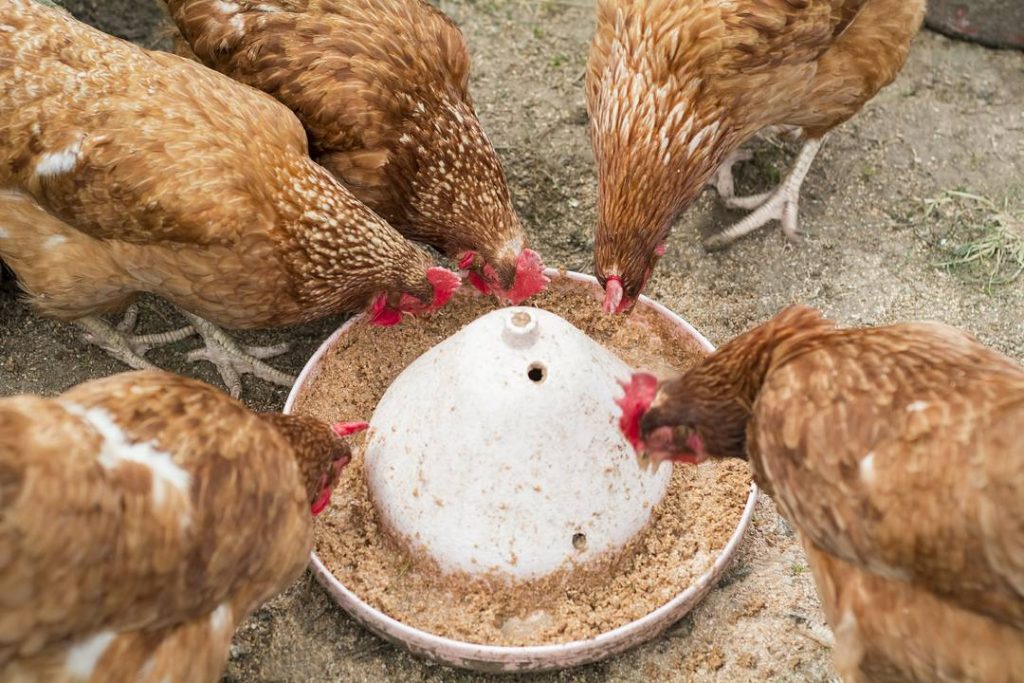This article discusses feeding chickens from young chicks through to fully grown laying hens for backgarden poultry keepers.
We’ve selectively bred our chickens to be far more productive than their wild ancestors. No wild bird could eat enough to lay 200, 300 or more eggs a year. To achieve this they need to take in the right amount of nutrition to convert to all those eggs as well as keep themselves healthy.
The problem is that the chicken’s system can only process a certain volume of food. This has not kept pace with their egg laying so if they eat as much low quality food as they can, they will not get enough nutritional value to keep them going.
Compound Feeds
The easiest way to feed your hens is with bought-in compound feed. A compound feed is simply a feed that has been manufactured to include all the necessary vitamins and minerals along with a balanced amount of protein, oil, fibre and carbohydrates.
Supplemental Feeds & Treats
Supplement this feed with greens and treats by all means, but ensure they take onboard enough balanced compound feed first. If you allow your birds to fill up on treats and greens then they just won’t have the room to take onboard food containing the nutrients they need. They’re just like children, really. They’ll fill up on sweets but have no room for dinner.
Feeding Chicks
For chicks with their specific nutritional requirements, you buy a specific chick crumb which is easy for them to peck and is formulated to help them grow. You can also buy feeds with added medication, specifically coccidiostats, which is a good idea.
Don’t worry if the mother hen also eats the chick crumbs with her offspring, they won’t do her any harm.
Growers Feed
Once they reach six to eight weeks old, it’s time to move them on to growers pellets. To help them make the transition for the last week on crumb, mix the growers pellets into the food 50/50.
Feeding Laying Hens
Once they’re grown to point of lay around 18 weeks old, again mix the growers pellets 50/50 with layers pellets to get them used to the change.
Feeding Chickens – Pellets or Mash?
Although pellets are easier to use, if you take on new birds, then they may prefer the mash and not even recognise the pellets as food. Rescued hens who may have been subjected to beak trimming, will find mash easier to cope with.
Feeding Through the Day
As a general rule, the first meal of the day should be compound feed. Their crops will be empty and so they’ll fill up on the healthy option. Do make sure the feeders are full and available all day so they can pick ad lib. Remember, in the wild eating is what they do all day and their system is geared to little and often.
Other feed types such as wheat and corn should be fed as treats only in moderation and after the chickens have eaten a good quantity of their layers pellets for the day. A small handful scattered on the ground is the best way to give them these feeds.
It can be a good way of getting your chickens back into their poultry house at night and you will find that after only a few days your girls will sit waiting come “treat” time so it also forms a good bonding with your pets and can help tame even the flightiest bird.
More on Feeding Chickens
- Best Grass Seed Mix for Chickens – Poultry Pasture Seed Mix
- Feed Your Back Garden Chickens More Greens
- Feeding Chickens – Nutritional Requirements & Sources
- Feeding Chickens Eggshells, Crushed Oyster Shell & Grit
- Feeding Chickens from Chicks to Laying Hens for Backgarden Keepers
- Feeding Chickens on Food Scraps and Waste Food
- Growing & Feeding Sprouted Wheatgrass Fodder to Hens
- Herbs For Hens – A Useful Dietary Supplement
- Pasture Feeding Hens for Better Eggs
- Why we should avoid Soya in Animal & Poultry Feed


